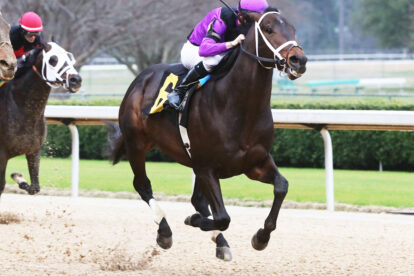So, You’re Thinking About Racehorse Ownership?
The purpose of the Racing Dudes dedicating a section to racehorse ownership is to provide an objective and educated perspective. If you have ever thought about owning a racehorse, then we want you to enter into this purchase well-prepared and with realistic expectations. Members of our team have purchased into syndicates, so our personal experiences may be injected for perspective and guidance (we will note opinions). We hope that our research and experiences can be of use, but the decision to invest in a racehorse is purely a personal choice.
If you were born into oil money and have access to a converted horse-transporting 747 that you cooly breeze into Keeneland for the September sales, then you probably don’t need the Racing Dudes’ advice. But, if you weren’t, and you’re willing to invest $100 to $50,000 a year into four-legged athletes, then we can help you through the ownership process.
We’ve broken out this process into four steps:
- What kind of racehorse owner would you like (and can afford) to be?
- With an established budget, how do you find the right ownership fit?
- What kind of racehorse ownership syndicates are available?
- How do I pick the horse racing ownership syndicate that’s right for me?
Additionally, we’ve provided our guidelines as to the type of syndicates that you should consider at the following budget levels:
- “Maiden” Level: less than $3,500
- “Allowance” Level: $3,500 to $20,000
- “Stakes” Level: more than $20,000
Good luck!
Step One: What Kind of Racehorse Owner Would You Like (and Can Afford) to Be?
This is a very important first step because it will help you narrow down your ownership choices. Here are a few of the questions that you should ask yourself as you get started:
How much am I willing to spend?
Much like buying a car, a house, or swamp land in Florida, you have to determine a realistic budget. Keep in mind that the purchase price is just the beginning of your expenditures. If your group buys a yearling (a 1-year-old), expect to pay for several things before your horse even sniffs the starting gate in an actual race:
- Breeding analysis
- Medical evaluations
- Ear exams
- Tooth cleaning
- Van transportation
- Training
- Shots
- Horse shoes
- TUMs (for you)
- Massage therapy (for the horse, not you)
- Acupuncture
- Hay
- Stall space
- Name tags
- More hay
- Psychological therapy (for both of you)
- Scopes and MRIs
Annual expenses for a thoroughbred can cost anywhere from $25,000 to $50,000. For context, the expenses for our horses averaged about $40,000 apiece in 2019. Let’s say you committed to 10% of a horse that cost $50,000 to purchase and $40,000 to keep it well-fed and happy for a year. Your expenses would run approximately $9,000 for the first 12 months of ownership (purchase price + expenses). As many owners have learned over time, that $5,000 claimer likes to eat just as much as a Breeders’ Cup champion.
At this point, you’ve spent $9,000 BEFORE your little darling has ever run for cash money. Like any elite athlete, thoroughbreds have no preset timetable in which they will figure out how to run with a little person on their backs, turn left, and gallop like hell when the gates open. Not even Bob Baffert can tell you on January 1 when (or if) his 2-year-olds will be ready to race.
What are some budget scenarios?
Maybe that quirky, somewhat-likable uncle of yours in Alaska just passed away and left you $50,000. Not only do you now remember him as much less weird and much more endearing, but his generosity has allowed you to begin building your very own Equine Fund. Your uncle’s $50,000 gift should be enough to cover the cost of purchasing and training three horses (bought for $40,000-70,000) at a 10% ownership level for a couple of years. Assuming that you bought three yearlings in September of Year 1, your expenses for this first year might run $19,000 (purchase price + three months of expenses). For Year 2, you’re looking at expenses of $10,000-12,000.
In this example, your two-year total investment (purchase price, training, food, owners’ license, doctor’s fees, etc.) would likely total $32,000-40,000. You’d still have some of your uncle’s money left to pay for a kickass suit, gas money, champagne, and plane tickets to visit and watch your adorable long-legged investments.
For the purposes of demonstration, say that you have a twin brother who also enjoyed the largess of your Alaskan uncle, so you both received $25,000. You could then reduce your share to 5%, resulting in a two-year total investment of $16,000-20,000.
Finally, consider another scenario. Maybe you have nary a relative who likes you enough to put you in a will. You have no prospect of a windfall inheritance, so you decide to sell your comic books, your Star Trek action figures, your Beanie Babies, your baseball card collections, all to fund your lifelong dream of racehorse ownership. After haggling with the weird dude at the strip mall, the liquidation of your childhood treasures has left you with $5,000.
While $5,000 is a decent amount of money, the cold hard fact is that you will be hard-pressed to purchase and pay expenses for more than one horse at a 5% ownership level.
Using the example above, if you bought 5% of a yearling that was purchased for $50,000, your total expenditures (purchase and expenses) through Year 2 would total $4,500-5,000. Now, maybe this yearling will develop into the next Justify, but it more than likely won’t. On top of that, does the idea of and liquidating your childhood memories into just one hay-eatin’, stall-sleepin’ animal scares the livin’ bejesus out of you? You should consider other options.
Does that mean that you have to squash your Mint Julep dreams and invest in something safe and practical, like Bitcoin, commemorative plates, or REITs? No way! All is not lost. With a $5,000 budget, consider partnering with some other sap – a buddy or sibling, perhaps – to pool your funds and buy into a syndicate. You can also consider the microshare option, which we’ll detail later. Under this microshare scenario, you join hundreds of others who are purchasing tiny shares of a horse, much like a stock.
Some opinions/thoughts at this stage…
In our opinion, owning 5% of three horses feels better than just 15% of one. You spread the risk and get to follow three times the horse flesh, which can mean three times the action. Of course, owning 5% of Justify versus 15% is the difference between my retirement fund and Warren Buffett’s, but – whoa Nellie! – how about being satisfied with 5% of $60 million? No one likes a greedy horse owner.
If you’re not willing to budget at least $7,500 in Year 1 (and likely another $4,000 in Year 2), then you should likely look at racehorse ownership options below the “Stakes” level. This is certainly not a hard-and-fast rule, but this strategy will allow you to learn the business with lower risk and determine if you have the patience and stomach for four-legged investing.
Based upon our research and experiences, we’ve created three racehorse ownership categories based on budgeted amounts:
- “Maiden” Level: less than $3,500 – the best option for this budget level would be to consider microshare racehorse ownership syndicates, such as MyRacehorse and the Churchill Downs Racing Club.
- “Allowance” Level: $3,500 to $20,000 – if you’re intrigued by the idea of a public syndicate option, then you’ll likely need to pool funds with another friend or investor. Some other syndicates cater to lower entry points, such as Pocket Aces, Dare to Dream, and Pewter Stables. Another option is to look for private ownership groups that will accommodate 2.5% ownership levels or lower, and/or invest in lower-cost horses.
- “Stakes” Level: more than $20,000 – you should have the funds to get involved with one of the major public racehorse ownership syndicates, such as West Point, Eclipse, or Little Red Feather.
Again, these are not hard-and-fast budget levels, but they should provide you with guidelines as to which kind of racehorse ownership syndicate you should be considering.
Step Two: With Budget Established, How Do You Find the Right Ownership Fit?
You’ve determined how much you can allocate for your Equine Fund. Here are some questions to ask that will help guide you to the right kind of syndicate or ownership platform:
What is my financial risk tolerance?
We do not advise placing 401ks or kids’ college savings into your prospective Equine Fund. Consider your Equine Fund to be at the extreme end of the “high risk” portion of your investment portfolio. Be prepared to lose some – or even all – of it. If your investments cannot absorb that kind of kick in the butt, then you might be better off buying two or three shares of Amazon stock (sorry, sometimes the truth sucks).
As a general rule of thumb, depending upon your stage in life and your risk tolerance, our advice is to allocate no more than 2-3% of your investable assets into an Equine Fund. If you have $500,000 set aside, assume that you can work with a budget of $10,000-15,000, though again, the exact percentage is totally up to you.
How long am I willing to stick it out?
If your group buys yearlings, you won’t see any kind of return in Year 1; depending upon your investment strategy, Year 2 will likely test your patience. Trust me on this: 2-year-olds are like teenagers. The’re busy trying to figure out who they are and where they want to be, and sometimes, that’s nowhere near a race track. Many juveniles begin real racing by mid-to-late summer, but this can vary greatly. In our case, all but one of our babies ran in 2019, though none raced more than three times.
The lone holdout looks like she’ll be ready to run soon after a delayed debut attributed to minor injuries, random illnesses, and immaturity. If you have teens of your own, you get it. Hopefully, our patience will be rewarded, but each horse has its own timetable. Some have immediate drive and competitive passion, while others would rather chase flies.
Can I watch my horse(s) in person?
If you live within an easy commute of a track and you want to see and smell your horse in person, then this will also determine where you will be sending your hard-earned (or lucky-to-inherit) money. If this is important, then find out where your potential syndicate typically runs its horses.
What level of races do I want to be able to enter and at what race tracks?
Similar to the question above, but another important consideration. If you want to see your horse race at the top tracks like Saratoga, Gulfstream Park, Churchill Downs, Santa Anita Park, Oaklawn Park, etc., then you;ll likely need to step up to the “Stakes level” investment. Let’s say you live near a track that features $5,000-10,000 purses and you have no plans to travel anywhere else. In this case, you can likely get involved at the “Allowance level” and do just fine.
Will my horse(s) run on weekends?
This is certainly not a hard-and-fast rule, but you will tend to see the better horses run on Saturdays and holidays when the crowds and purses tend to be bigger. The horses that compete in these races often command a higher purchase price (at least $50,000), but there are certainly outliers. Big purchase prices do not guarantee big returns.
Do I need to be schmoozed?
If sitting in a private box, wearing nifty hats, and gaining access to special events is important, then look for a syndicate that offers these benefits. Of course, these costs will be built into the purchase price, but these fun perks can certainly enhance your experience.
Do I want someone handling the details?
There’s a reason why the bigger syndicates charge a fee — they do the pre-purchase research, hire the trainer, etc. However, if you find a group that you trust and you don’t mind keeping track of the bills, then the private route might provide a more economical and efficient choice.
Step Three: What Kind of Racehorse Ownership Opportunities are Available?
Let’s take a look at the type of ownership options, starting with the least to most costly:
Microshare Online Syndicates. These web-based companies, like MyRacehorse.com, work much like public syndicates, except that ownership offerings are much smaller than those of other syndicates (typically 0.01% to 0.1% minimum investments). In addition, this option may offer the investor immediate action, as many of these horses are race-ready. Additionally, the purchase price, the training, and all other expenses are built into this horse’s price per share.
The company offering to sell these horses should give potential investors the horse’s breeding history, a general profile of his/her training to this point, and the trainer’s name. It should also disclose any additional expenses or fees that investors are expected to cover.
These small share offerings are a way for people to “test the waters” and get a feel for what horse ownership feels like, without making a significant investment or taking on a huge amount of risk. You can get involved in owning a horse for as little as $100.
Microshare Race Track Syndicates
These are structured like the digital offering above, except that you are working through the race track to manage and train the horse.
These tracks, like Churchill Downs, may offer one or two horses per racing season. If interested in this option, search the track’s website to see when/if this might next be available.
Public Syndicates
Generally, these syndicates purchase a horse, build in a management fee, then offer prospective investors the chance to buy into the horse at increments ranging from 2.5-25%. The shareholder is sent monthly or quarterly bills (as well as winnings!) and may have access to perks like logoed merchandise, cheese trays, cold beers, box seats, paddock access, and behind-the-scenes experiences.
Private Syndicates
These tend to be word-of-mouth or friend-to-friend situations where a group pool resources to purchase a horse (or horses) and divide shares based on the amount that each person invested. The biggest difference between this arrangement is that private syndicates usually do not charge any management or markup fees. They tend to take all of the bills (and winnings) and divide them equally among shareholders.
Step Four: How do I Pick a Specific Racehorse Ownership Syndicate that is Right for Me?
You’ve reached the point where you have determined how much money you are willing to commit and that a public syndicate is a good fit for you. Here are some of the questions you consider asking the syndicate group…
- What is your strategic direction? What separates you from other syndicates?
- Is your goal to win the Triple Crown and other 3YO showcase dirt races?
- Do you primarily purchase colts or fillies? Do you purchase dirt and/or turf horses? All of the above?
- Are you taking a long-range perspective to capture 3YO+ winnings as well as breeding rights?
- Do you buy horses one at a time? Or, do you gain investor interest and pool funds to purchase a stable of horses?
- Do you sell off 100% of your horses to investors or do you hold onto some shares? In other words, do you also have “skin in the game?”
- How does your company make money? Markup fees? Winnings? Sales?
The following provides a brief profile of some of the syndicates available for those interested in horse racing ownership. This is, by no means, an all-encompassing review of available syndicates. Rather, it is meant to give you a glimpse into the structure and offerings of a few syndicates at various price points: Economy, Mid-Range, and Premium levels. We’ll start with the least expensive racehorse ownership option:
Microshare Syndicates: “Claiming Level” Investment
These options are built to make purchasing a share of a horse very easy and inexpensive. All the paperwork, details, and management of the horse is built into the share price, so it is a one-time fee.
MyRacehorse
The group with https://myracehorse.com offers shares for as little as 0.01% in a wide range of horses, many of whom are high-quality purchases and have well-known trainers (Baffert, Pletcher, Mandella). This is a great way to experience horse ownership, as the purchase process is very easy: you pay a one-time fee and your horse is ready to run. Also, all of the costs are laid out for you ahead of time. The ease of purchase comes at a cost, however; for example, a recent juvenile colt sold for $90 for a 0.01%, so if you wanted to own 1% of this horse, then it would cost you $9,000. This horse was purchased at the Ocala 2019 sale for $550,000, so you’re paying a premium.
Race Track Syndicates
Many racetracks have entered into the syndication business to encourage fan participation. They may offer one or two horses a year and the deals are structured much like the myracehorse.com offering, but are managed by the race track. If you frequent a track near you and this is of interest, check with the website to see if they offer this kind of option. For example, here is the offering for the Churchill Downs Racing Club: https://www.churchilldowns.com/racing-wagering/racingclub
Mid-Range Budget Public Syndicates: “Allowance Level” Investment
The syndicates at this level will typically purchase a yearling (or active horse) and offer up shares for purchase by partners. Many provide track access and communication with trainers, etc. These sites will provide a lot of in-depth information, but you should definitely reach out to the owners for more information.
Pewter Stables: http://www.pewterstable.com/partnership-offerings.shtml – Pewter’s horses tend to race in the Northeast and it offers 2.5% to 10% ownership stakes. According to its site, it does not charge a markup fee. Based upon its pricing, you could build a two- or three-horse stable at 5% ownership level for $4000 to $10,000 annually.
Pocket Aces: https://www.pocketacesracing.com/ – Pocket Aces’ typical partnership offerings can sell for $1500 to $10,000 apiece and they do not markup the purchase price. Their horses run primarily east of the Mississippi on tracks like Keeneland, Fair Grounds, Churchill Downs, Turfway, and others. Based upon its pricing, you could build a two- or three-horse stable at 5% ownership level for $6000 to $12,000 annually.
Dare to Dream Stable: https://www.daretodreamstable.com/ – An Illinois-based syndicate, Dare to Dream currently has 16 horses in its stable that will run across the country, primarily east of the Mississippi. Based upon the structure of its offerings and current offering it has listed, you could build a two- or three-horse stable at 2% ownership level for $5500 to $10,000 annually.
Premium Public Syndicates “Stakes Level Investment”
All of the following syndicates follow a similar model: they purchase a horse and add a markup fee. This fee can range from 25% to 100% and it can cover everything from bloodline research to vet bills to expert trainer analysis. You can often determine the markup by researching the purchase price of the horse and then comparing that to the offering price. Much like buying a premium brand name, you are paying for the collective equine expertise of the syndicate.
In addition, these three syndicates offer special owner experiences, hosted events, behind-the-scenes access, exclusive content, and tickets (box seats, tickets, etc.) You can also research the general success of the syndicates by comparing things like Graded Stakes placements, percentages placing in the money, overall winnings and average earnings per start.
These are not hard-and-fast costs, but a minimal initial investment in these syndicates would likely fall in the range of $20,000 to $100,000 annually, depending upon the purchase price, % of ownership and the number of horses purchased.
West Point Thoroughbreds (https://www.westpointtb.com/)
- Business Model: West Point buys at the top sales (Saratoga & Keeneland, for instance) at price points ranging from $75,000 to $450,000. West Point purchases yearlings, 2YOs, and already-raced horses — it will then build in costs (training, legal fees, travel, etc.) as well as a fee, so there is margin built into the cost of a horse. It will sell 100% of the horse’s shares. Advice on how to view an equine investment from one of its salesmen: “treat it like vacation money.”
- Differences between West Point and others: coast-to-coast racing, large staff support, experienced syndicate, top trainers like Clements, Sadler, Romans, etc.
Eclipse Thoroughbred Partners (https://eclipsetbpartners.com/)
- Business Model: Eclipse tends to buy 2YOs after they have had a chance to see them run and they will also participate in the September yearling sales. They sell shares at 6% to 24% increments and they keep 4% in each partnership. Eclipse sells racehorse ownership opportunities one at a time and like West Point, will build in a fee to mark up horses by 20% to 40%, depending upon the purchase price. Eclipse generally will have 60% colts and 40% fillies in its stable at any given time. (*Per an announcement made 3/16, Eclipse will reduce its minimum ownership level from 6% to 3% for any of its upcoming 2YO purchases at Ocala.)
- Differences between Eclipse and others: offers racing across the country, top trainers like Pletcher, Motion, etc. “At the end of their career, we have the horses placed in a good home” said the salesman.
Little Red Feather http://www.littleredfeather.com/
- Business Model: Little Red Feather has approximately 450 partners and may own 80+ horses at time. Like the others, it will participate in the September yearling sales, but it will also purchase experienced horses and offer shares. In addition, offers other investments: a pinhooking fund (in simple terms, they buy a yearling, train it, and sell it as a 2YO) and a claiming fund (LRF will look for opportunities to “claim” active race horses and offer them to investors.) Like the other syndicates, LRF will mark up a horse it has purchased and then divvy up shares and they will often hold 5% ownership.
- Differences between LRF and others: races its horses almost exclusively on the California tracks, but will have some running on east coast at times
- Miscellaneous: LRF has created a very useful guide on racehorse ownership: “10 Things You Must Consider Before Joining a Horserace Syndicate” — some useful tips and insights that are not specific to Little Red Feather that is worth downloading.
Other “Stakes level” public syndicates:
- Team Valor International: http://www.teamvalor.com/
- Bradley Thoroughbreds: https://bradleythoroughbreds.com/
- Donegal Racing: https://www.donegalracing.com/
- Ten Strike Racing: http://tenstrikeracing.com/
NOTE: The syndicates listed in this article are in no way meant to provide a comprehensive list of ownership opportunities. These are examples of syndicates that we have had experiences with thus far. If you would like to have your syndicate listed, please email us at contact@racingdudes.com with your website, investment strategy, minimum investment, # of horses in stable, trainers, where you race, etc., so that we can discuss your placement.










